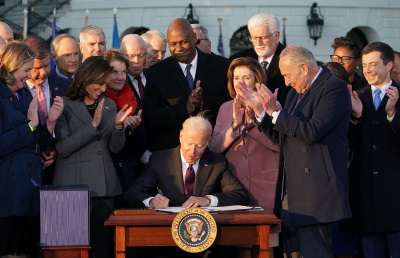
Both President Joe Biden and Vice President Kamala Harris lauded the bipartisan infrastructure legislation for creating good-paying jobs for “millions” of Americans. But they meant millions of job-years, not millions of additional jobs.
In fact, estimates of how many additional jobs the law will create range from not many to about 1 million over 10 years. The $1.2 trillion act includes about $550 billion in new federal spending over five years.
It is possible that millions of people could be affected, if there are a lot of part-time, part-year and short-term positions. The job-year concept, though, is not the standard way of measuring the impact on employment and not clear from Biden’s or Harris’ remarks.

On Nov. 6, after the House passed the infrastructure bill, Biden said in a statement that it “will create millions of jobs,” and just before Biden signed the legislation into law on Nov. 15, he said: “It creates better jobs for millions of Americans.” Harris also said at the bill-signing event: “After this bill is signed into law, millions more Americans will go to work in good-paying good union jobs.”
If listeners thought that meant the bill was expected to increase national employment by “millions” of additional jobs, they would be mistaken. A Nov. 4 report from Moody’s Analytics, which the White House has cited, shows the peak employment gain due to the infrastructure legislation alone would be 872,000 jobs in the fourth quarter of 2025, compared with the level of employment without the law. We asked Mark Zandi, chief economist at Moody’s, about the White House remarks, and he said he suspected the reference was to millions of “job-years.” The White House press office confirmed to us that was the case.
A “job-year” is “one job for one year,” as explained by then-President Barack Obama’s Council of Economic Advisers in 2009. The CEA argued then that this was a worthy measure in a down economy, but it’s not the same as the total jobs created. If one person holds one new job for two years, that’s two job-years, as opposed to one job.
“Since the economy is likely to be operating below capacity for several years, job creation any time over the next several years is valuable,” Obama’s CEA said in a May 2009 document on job creation expected from the American Recovery and Reinvestment Act. “Thus, a second way to look at the employment effects of the program is to estimate the number of job-years the program will create over the President’s first term.”
The CEA estimated the legislation would save or create 3.5 million jobs by the fourth quarter of 2010. But when considering job-years, that figure rose to 6.8 million by the end of 2012.
The math involves simply adding the estimated average job gain per year due to the legislation, compared with what employment would be without the law. That’s the way the Biden White House calculated “millions” of job-years as a result of the Infrastructure Investment and Jobs Act.
Job Creation Estimates
Moody’s estimated an increase in employment due to the infrastructure legislation wouldn’t begin until the fourth quarter of 2022. Infrastructure projects don’t launch immediately. The peak impact is an estimated 871,700 jobs, beyond what would be expected without the law, in the last quarter of 2025. The impact then declines to 104,300 jobs above employment without the law in the fourth quarter of 2031.
But by adding the estimated employment gain for each year, the impact is 4.15 million job-years.
Gary Burtless, a senior fellow and labor economist at The Brookings Institution, told us in an email that the concept of job-years “is hard for some folks to grasp,” but he said “it is probably the most practical way to measure the employment impact of legislation over a fixed period of time, such as during the next 5 years.”
Some of these job-years would be one job held for more than one year. However, some job-years could be “part-time or part-year, so that more than one worker will see his or her work hours raised as a result of the legislation, even if [the] law only boosts the number of ‘job years’ by exactly one (1),” Burtless said. “For that reason, the effect of the legislation may have impacts on the work hours and jobs of more than a million people, even when the number of ‘job years’ created by the legislation is exactly one million ‘job years.’”
This isn’t the first time public officials have used the job-years calculation, and news organizations have noted in the past that there is some value to it — though politicians need to be clear about what they’re saying. Construction jobs are usually temporary and could last six months or several years, so the job-year figure could be a more detailed way of looking at the impact.
But other economists we contacted weren’t too keen on using the measure.
Georgetown University’s Center on Education and the Workforce estimates the infrastructure law will create about 1 million jobs over 10 years. That’s similar to S&P Global Ratings’ estimate of 883,600 and a bit higher than IHS Markit’s projection of 750,000 jobs.
Nicole Smith, CEW’s chief economist, told us in a phone interview that the organization also believes the money from the infrastructure law “will still save a significant amount of jobs as well.”
Using the job-years measure “just gives you a bigger number” than the standard definition of a job created and is “an unnecessary convolution of the idea,” Smith said.
When the average person asks about jobs created, “they want to know how many jobs,” she said, “jobs that didn’t exist before.”
Penn Wharton Budget Model Faculty Director Kent Smetters told us he hasn’t heard of job-years “being used in this context before.”
“It’s certainly not standard,” he said in a phone interview, “not the way we typically talk about it.” Smetters pointed to the Bureau of Labor Statistics’ employment projections, which look at the change in employment over 10 years. “It’s not counting every single year that someone has a job as 10 jobs,” he said.
However, the “definition of a job is now suddenly ambiguous,” Smetters said, which is why the Penn Wharton Budget Model prefers to look at the impact on hours worked. Factors such as part-time gig work mean an impact on employment could be more hours worked rather than actual job creation.
As for the infrastructure law, PWBM estimated the impact on hours worked, while positive, won’t be significant. The effect is “so low that we didn’t want to put out a number,” Smetters said.
PWBM estimated that only 60% of the $548 billion in new federal spending in the law is “truly new,” because state and local governments will be able to use some of the funding for projects they would’ve otherwise done anyway. Plus, it will take two to three years for infrastructure projects to begin, at which point PWBM believes the economy will be back to full employment. The impact would then fall more on wages than jobs or hours, as some workers are enticed away from existing jobs to work on infrastructure.
One reason PWBM finds little impact on employment while other models estimate about a million new jobs concerns the gap between potential gross domestic product and actual GDP. PWBM adjusts potential GDP for the economic situation with COVID-19. The issue now, Smetters said, is mostly that employers can’t find workers, not that people can’t find work.
As a result of a lower adjusted potential GDP, “we actually say that there is not a lot of slack in the economy right now because of the choices people are making,” he explained. And two to three years down the road, “we’re already back to, in our model, to the natural rhythm of employment.”
Still, as we’ve said, other estimates have found the infrastructure law would create an additional 750,000 to 1 million jobs.
The day after signing the law, Biden went much further than that, telling a crowd in New Hampshire: “It’s estimated it’ll create thousands — excuse me — up to two extra — 2 million jobs extra a year, and up to 16 million jobs nationwide. Good-paying jobs. Union jobs.” Even by the “job-years” measure, however, that’s wrong. And it’s not the first time Biden has falsely claimed the infrastructure bill would create up to 2 million jobs a year.
Biden is including the impact of the $1.75 trillion reconciliation bill, which addresses child care, health care and climate change. If that bill is enacted into law, it, along with the infrastructure law, would create 2.4 million additional jobs by the middle of this decade, Moody’s Analytics estimated.
Biden’s 16 million figure also appears to be a reference to job-years.
Editor’s note: FactCheck.org does not accept advertising. We rely on grants and individual donations from people like you. Please consider a donation. Credit card donations may be made through our “Donate” page. If you prefer to give by check, send to: FactCheck.org, Annenberg Public Policy Center, 202 S. 36th St., Philadelphia, PA 19104.
The post White House Uses ‘Job-Years,’ Not Jobs, to Tout Infrastructure Law appeared first on FactCheck.org.
This post was originally published on FactCheck.org.